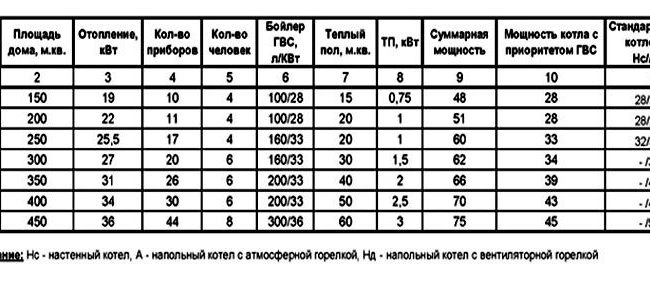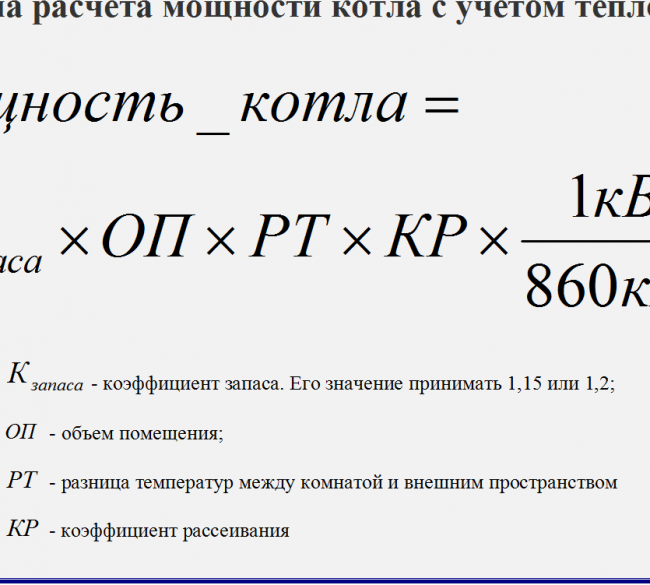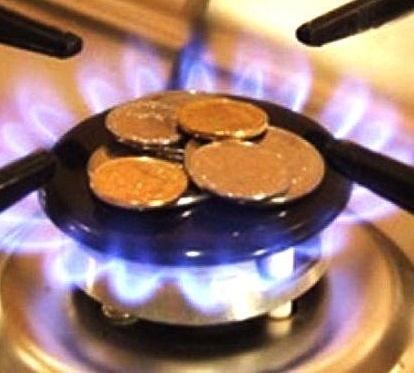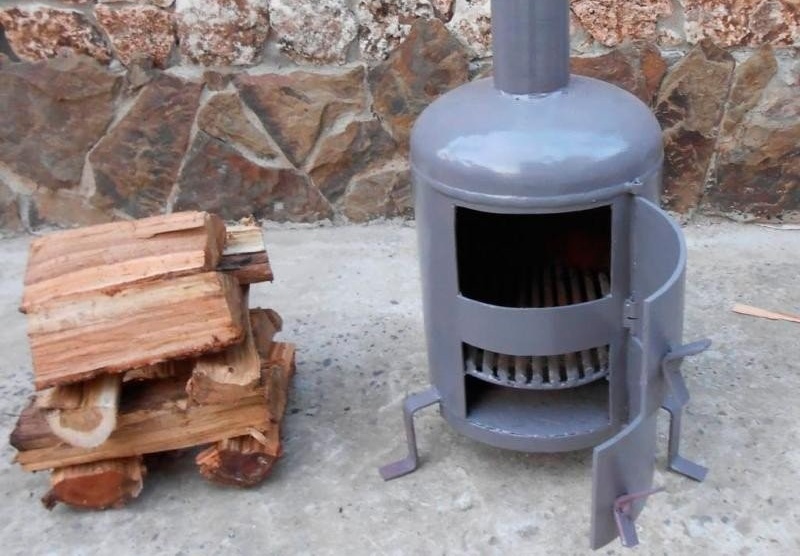How to calculate gas flow: a detailed guide
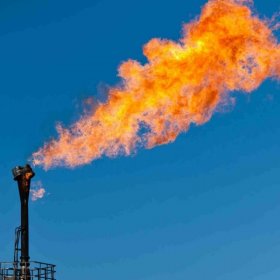
The natural gas mixture currently belongs to the category of the cheapest, but relatively affordable types of energy resources in different regions. There are several basic methods, using which you can quickly calculate the gas flow rate for maximum efficiency of the equipment while taking into account averaged indicators.
Content
How to calculate gas consumption for heating a private house and hot water (with formulas)
Gaseous fuels can be represented by propane, butane, methane, hydrogen, as well as traditional natural gas. The reserves of natural gas exceed the volumes of oil and coal; therefore, it is important to make a competent calculation of such an economical energy carrier used in heating systems for cooking and other household needs, including hot water supply.
Calculation of boiler power
Competent independent calculation of the total gas flow will not require special skills, given the basic parameters of the equipment.
To perform independent calculations, you need to know the level power of the used boiler and floor space, as well as use tabular data.
Around the clock operation of the unit in a monthly mode involves the multiplication of data in order to obtain kilowatt hours. The choice of unit power is based on the total area of home ownership, and when calculating the consumed volume of blue fuel, you must always focus on the lowest temperature indicators outside the window.
By quadrature
It is important to remember that in order to calculate by quadrature, it is necessary to find the derivative of the equipment capacity by the number of hours per day and the number of days per week. It is especially important to correctly calculate the energy consumption for heating according to the operating mode and taking into account the use of 1.0 kW for every 10 m² of heated area.
Table: indicators for calculating fuel consumption
| Total area in m3 | Maximum gas consumption for heating |
Optimal volume boiler |
| 100–200 | 20 kW | 160-200 l |
| 150–200 | 25 kW | 160-200 l |
| 150–300 | 30 kW | up to 300 l |
| 200–400 | 40 kW | up to 300 l |
| 300–500 | 50 kW | up to 500 l |
For example, for a full-fledged, as well as the most effective space heating with a total area of 30 m², it is necessary to purchase a boiler with a capacity of only 3.0 kW. Therefore, to heat one square meter of area, it will be necessary to spend 100 watts of thermal energy, taking into account the room height of up to 300 cm
Calculation formula:
V = Q / (q x Efficiency / 100), where:
- V - standard indicators of volumetric gas flow per hour for each cubic meter.
- Q - heat loss and power of the heating system in kW.
- q - the lowest specific energy content in kW / m³.
- Efficiency - indicators of the efficiency of the operated equipment.
For example, to warm the air masses in a room with a total area of 90 square meters, V = 9.0 / (9.2 x 96/100) = 9.0 / 9.768 = 0.92 m³ / h.
Taking into account heat loss
The individual norm, taking into account power indicators, is calculated in accordance with the formula:
TOapp × OP × RT × KR × 1 kW / 860 kW, where:
- TOapp is a correction value of 1.15 or 1.20.
- OP are indicators of the total volume of the room.
- RT is the difference in temperature in the room and outside it.
- Raman scattering coefficients are indicators.
For example, 1,000 mg of standard fuel is 7,000 kcal, and in other terms, 7 × 10 - 3 Gcal, while the ideal consumption under conditions of 1 efficiency is the specific consumption of a conventional unit of fuel for generating 1.0 Gcal of heat.
Table: territorial correction values for annual norms of heat consumption for cooking and hot water supply in the Central Federal District
| Region | Values | ||
| Hot water supply | Cooking food | ||
| Without gas water heating equipment | With gas water heating equipment | ||
| Belgorod | 1,20 | 1,19 | 1,11 |
| Bryansk | 1,24 | 1,23 | 1,17 |
| Vladimir | 1,28 | 1,26 | 1,23 |
| Voronezh | 1,22 | 1,22 | 1,14 |
| Ivanovo | 1,30 | 1,28 | 1,26 |
| Kaluga | 1,26 | 1,25 | 1,20 |
| Kostroma | 1,30 | 1,29 | 1,25 |
| Kursk | 1,23 | 1,22 | 1,16 |
| Lipetsk | 1,24 | 1,23 | 1,14 |
| Moscow region | 1,28 | 1,27 | 1,19 |
| Moscow | 1,27 | 1,26 | 0,92 |
| Orlov | 1,25 | 1,24 | 1,15 |
| Ryazan | 1,26 | 1,25 | 1,20 |
| Smolensk | 1,26 | 1,25 | 1,17 |
| Tambov | 1,24 | 1,23 | 1,16 |
| Tver | 1,28 | 1,27 | 1,23 |
| Tula | 1,25 | 1,24 | 1,17 |
| Yaroslavl | 1,30 | 1,28 | 1,23 |
Table: territorial correction values for annual norms of heat consumption for cooking and hot water supply in the NWFD
| Region | Values | ||
| Hot water supply | Cooking food | ||
| Without gas water heating equipment | With gas water heating equipment | ||
| Karelia | 1,33 | 1,31 | 1,25 |
| Komi | 1,39 | 1,36 | 1,29 |
| Arkhangelsk | 1,38 | 1,35 | 1,31 |
| Nenets Autonomous Okrug | 1,52 | 1,47 | 1,49 |
| Vologda | 1,33 | 1,31 | 1,26 |
| Kaliningrad | 1,18 | 1,17 | 1,09 |
| Leningrad region. | 1,30 | 1,29 | 1,24 |
| Novgorod | 1,27 | 1,26 | 1,19 |
| Pskov | 1,25 | 1,24 | 1,18 |
| St. Petersburg | 1,26 | 1,25 | 1,14 |
Table: territorial correction values for annual norms of heat consumption for cooking and hot water supply in the Southern Federal District
| Region | Values | ||
| Hot water supply | Cooking food | ||
| Without gas water heating equipment | With gas water heating equipment | ||
| Adygea | 1,05 | 1,07 | 0,97 |
| Dagestan | 1,03 | 1,04 | 0,94 |
| Ingushetia | 1,07 | 1,08 | 1,03 |
| Kabardino-Balkaria | 1,11 | 1,12 | 1,01 |
| Kalmykia | 1,12 | 1,12 | 1,07 |
| Karachay-Cherkessia | 1,12 | 1,13 | 1,04 |
| Ossetia | 1,14 | 1,15 | 1,04 |
| Chechnya | 1,08 | 1,09 | 1,03 |
| Krasnodar | 1,05 | 1,06 | 0,92 |
| Stavropol | 1,11 | 1,12 | 1,00 |
| Astrakhan | 1,10 | 1,11 | 1,00 |
| Volgograd | 1,15 | 1,15 | 1,06 |
| Rostov | 1,12 | 1,12 | 1,00 |
Table: territorial correction values for annual norms of heat consumption for cooking and hot water supply in the Volga Region
| Region | Values | ||
| Hot water supply | Cooking food | ||
| Without gas water heating equipment | With gas water heating equipment | ||
| Bashkortostan | 1,31 | 1,29 | 1,20 |
| Mari El Republic | 1,32 | 1,30 | 1,26 |
| Mordovia | 1,28 | 1,26 | 1,23 |
| Tatarstan | 1,30 | 1,29 | 1,20 |
| Udmurtia | 1,33 | 1,31 | 1,26 |
| Chuvashia | 1,31 | 1,29 | 1,24 |
| Kirov | 1,35 | 1,33 | 1,29 |
| Nizhny Novgorod | 1,29 | 1,27 | 1,20 |
| Orenburg | 1,27 | 1,26 | 1,21 |
| Penza | 1,27 | 1,25 | 1,20 |
| Permian | 1,35 | 1,33 | 1,26 |
| Samara | 1,27 | 1,25 | 1,11 |
| Saratov | 1,33 | 1,22 | 1,17 |
| Ulyanovsk | 1,30 | 1,28 | 1,22 |
| Mound | 1,35 | 1,33 | 1,30 |
| Sverdlovsk | 1,36 | 1,34 | 1,27 |
| Tyumen | 1,37 | 1,35 | 1,26 |
| Khanty-Mansiysk | 1,46 | 1,43 | 1,36 |
| Yamal-Nenets Autonomous Okrug | 1,65 | 1,56 | 1,55 |
| Chelyabinsk | 1,34 | 1,32 | 1,26 |
| Altai | 1,36 | 1,34 | 1,28 |
| Irkutsk | 1,43 | 1,40 | 1,35 |
| Buryatia | 1,49 | 1,45 | 1,49 |
| Kemerovo | 1,40 | 1,37 | 1,31 |
| Novosibirsk | 1,40 | 1,37 | 1,30 |
| Omsk | 1,38 | 1,35 | 1,30 |
| Tomsk | 1,42 | 1,39 | 1,33 |
| Yakutia | 1,73 | 1,66 | 1,67 |
| Khabarovsk | 1,36 | 1,33 | 1,27 |
| Sakhalin | 1,33 | 1,31 | 1,25 |
DHW fuel calculation
As practical experience shows, a family of four on average spends about 80 liters of hot water per day, which allows you to calculate the amount of heat used to heat the liquid:
Q = cm ΔT, where:
- C - indicators of the thermal capacity of water, comprising 4.187 kJ / kg ° C.
- m - indicators of the mass flow of water in kg.
- ΔТ - indicators of the difference between the initial and final temperature conditions.
The calculation suggests that there is no translation of the volume of fluid consumed into mass quantities, recognizing them the same. For example, at a water temperature of 70 ° C:
4.187 x 80 x 70 = 23447.2 kJ or 6.5 kW.
It remains to substitute this value into the formula taking into account the efficiency of gas equipment or a heat generator, which allows you to get volume data in m³ / h:
V = 1 / (q x Efficiency / 100)
For example, at a power of 6 kW, V = 6 / (9.2 x 96/100) = 6 / 8.832 = 0.68 m³ of natural gas is used to heat water.
How to calculate the flow of liquefied gas
For heating a room organized using such a gas, represented by propane or butane, there are several differences.
As a rule, in private households, special tanks are installed, represented by gas tanks, refueling for one heating season. The use for heating cylinders filled with gas is quite rare.
Table: average consumption of natural and balloon or liquefied gas, taking into account the power indicators of gas equipment
| Natural gas | Boiler power, kW | Liquefied gas, l3 / hour | |
| m3 / hour | m3 / year | ||
| 1,125 | 2689 | 10,0 | 0,865 |
| 1,685 | 4033 | 15,0 | 1,295 |
| 2,245 | 5377 | 20,0 | 1,725 |
| 2,805 | 6721 | 25,0 | 2,155 |
| 3,365 | 8065 | 30,0 | 2,585 |
| 3,925 | 9409 | 35,0 | 3,015 |
| 4,485 | 10753 | 40,0 | 3,445 |
| 5,605 | 13441 | 50,0 | 4,305 |
| 6,725 | 16129 | 60,0 | 5,165 |
To calculate the total consumption of liquefied or bottled gas, a standard formula is used with the specific heat data released during the combustion of energy. The parameters for propane are 46.0 MJ / kg, or approximately 12.8 kW / kg. For example, for home ownership with a total area of 90 m² when using a boiler with an efficiency of 90%:
V = 9.0 / (12.8 x 90/100) = 9.0 / 11.52 = 0.78 kg / h.
A liter of bottled fuel has a mass of 0.54 kg, so the energy consumption in liters will be 0.78 / 0.54 = 1.44 l / h or 34.7 l per day and 1042 l per month. Given the climatic conditions, the determination of the average value will require a reduction in the data obtained by half. For example, for the Moscow region, the figure will be 1042/2 = 521 liters per month, or about 17.3 x 214 + 3875 liters annually.
Is it possible to reduce fuel consumption
Economical consumption natural or bottled blue fuel is a completely feasible task, solved with the help of several simple measures:
- Purchase gas equipment with a high level of efficiency.
- To increase the efficiency of the heat exchanger in the gas boiler by installing circulating pumping equipment and a filter system.
- It is imperative to install standard pumping circulation equipment in systems with universal boilers, capable of working with different types of fuel.
- Fix foil isolon behind the heating batteries and install a small fan under the heater.
Equally important is the installation of the optimal operating mode on the operated gas equipment through modern automation, as well as the most effective insulation.
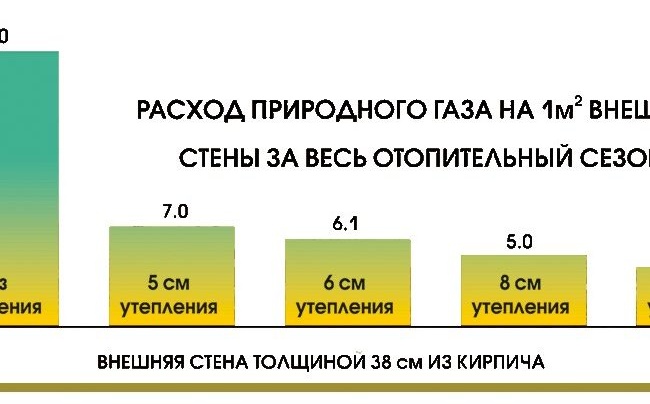
Natural gas consumption per 1 square meter of the external wall for the entire heating season, depending on the insulation
It is important to remember that volatile systems require a constant electrical supply and a stable voltage of 220 V.
Accurate calculations and a careful approach to the design of the heating system will avoid further large expenses for heating the cottage. From our next article you will learn about the principles of developing heating systems, choosing boilers and equipping a boiler room:https://aquatech.tomathouse.com/en/otoplenie/raschety/sistema-otopleniya-kottedzha.html.
Stable price increases of various types of energy carriers provoked a completely natural process of improving all types of heating equipment, including gas units. However, increasing the efficiency of such devices will require not only mandatory, but also competent calculation of gas consumption and the use of modern techniques to ensure maximum efficiency in the operation of gas equipment with minimizing fuel overruns.
